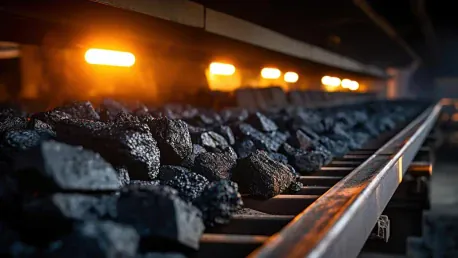In an era where energy demands continue to surge, the Trump administration’s initiative to resurrect coal as a primary energy source aims to address these increasing needs while stabilizing costs. President Trump has frequently emphasized the production of “beautiful, clean coal,” outlining its potential benefits in ensuring a steady and reliable power supply. With coal currently contributing about 15% of the United States’ power generation—down from over 50% at the turn of the millennium—the administration’s push appears to be a strategic move to revive an industry that once dominated the energy landscape.
The Current State of Coal Energy in the U.S.
Declining Coal Usage and Industry Impact
Despite coal’s significant decline in domestic energy production, the Trump administration aims to preserve the remaining coal plants to meet rising demands from power-intensive sectors. The artificial intelligence industry, for instance, is expected to increase energy demand from data centers by 10-20% annually through 2030. This surge in electricity usage underscores the need for a stable and reliable energy source, which coal can potentially provide. Manufacturing growth and the widespread adoption of electric vehicles add further strain to the aging U.S. power grid, making the case for a diversified energy mix more compelling.
Energy Secretary Chris Wright underscored a “market-based” strategy to prevent the shutdown of coal-fired power plants, with twelve plants currently slated for closure. This approach prioritizes maintaining these plants as an essential part of the energy mix, despite the availability of cheaper alternatives such as natural gas and renewable energy sources. Coal plants offer consistent baseload power, unlike intermittent renewable sources, which require substantial battery storage solutions. This consistency could prove crucial in ensuring a continuous power supply amidst growing energy demands.
Global and Domestic Production Trends
Global coal production has reached new highs, with the International Energy Agency reporting nearly 10 billion metric tons produced in 2024. This global increase in coal production contrasts sharply with the domestic landscape, where U.S. coal production has trended downward. However, exports have seen a noticeable uptick, particularly to energy-hungry nations like India, China, and Brazil. These exports highlight coal’s persistent relevance on a global scale, even as domestic consumption declines. Limited port access on the U.S. West Coast, though, remains an infrastructural hurdle, hampering further growth in coal exports.
The economic implications for communities dependent on coal mining cannot be overlooked. The preservation of coal plants not only aims to meet rising energy demands but also supports local economies reliant on coal-related jobs. The administration’s stance on coal reflects a balancing act between economic interests and emerging environmental concerns. As such, the interplay between domestic policies, global production trends, and the logistical challenges of exporting coal continues to shape the coal industry’s future.
Environmental and Infrastructural Challenges
Balancing Energy Demands and Environmental Concerns
The quest to stabilize energy costs through coal faces significant environmental opposition. Environmental advocates argue that reverting to coal increases carbon emissions and exacerbates climate change. Despite these concerns, coal remains a vital component of the global energy supply chain. The Trump administration’s approach reflects a broader debate about balancing immediate energy needs with long-term environmental sustainability. Strategies to mitigate coal’s environmental impact, such as incorporating carbon capture and storage technologies, play a part in this ongoing dialogue.
The infrastructural challenges in further expanding coal exports add another layer of complexity to the administration’s efforts. Port limitations on the U.S. West Coast restrict the potential for increased coal exports, crucial for balancing domestic production with global demand. Investment in infrastructure to support coal transportation could provide a solution, facilitating the export of American coal to international markets. This measure would not only bolster the coal industry’s global standing but also offer an economic boost to regions reliant on coal production.
Future Considerations for U.S. Energy Policy
As the U.S. navigates its energy policy amidst rising demands and environmental concerns, the role of coal remains contentious. Renewables and natural gas have already begun to supplant coal as the primary sources of energy for many regions. However, coal’s ability to provide consistent baseload power keeps it in the conversation. Innovations such as improved battery storage for renewables and advancements in carbon capture technology could lessen reliance on coal. Policymakers must weigh these emerging technologies alongside the immediate practicality of coal energy, particularly in high-demand scenarios.
The economic viability of coal plants also hinges on regulatory frameworks and market conditions. Any shift in policy could sway the future of coal energy, impacting decisions on whether to sustain or phase out coal investments. Energy Secretary Chris Wright’s market-based approach suggests that economic factors will significantly influence these decisions. Ultimately, the nation’s energy policy must address multifaceted challenges, balancing economic, environmental, and infrastructural needs to ensure a stable and sustainable energy future.
Navigating the Path Forward
In an age where energy demands are constantly growing, the Trump administration’s plan to revive coal as a main energy source aims to address these needs and keep costs stable. President Trump often highlights the production of “beautiful, clean coal” and its advantages in providing a reliable power supply. Currently, coal accounts for roughly 15% of the United States’ power generation, a sharp decline from over 50% at the start of the 2000s. This decline has led the Trump administration to focus on rejuvenating an industry that once played a dominant role in the energy sector. Advocates argue that boosting coal production can help ensure energy security and job creation, particularly in regions heavily dependent on coal mining. However, critics stress environmental concerns, highlighting the need for cleaner energy alternatives. Despite these debates, the administration believes that coal can once again become a cornerstone of the nation’s energy policy, balancing economic growth with energy independence.









